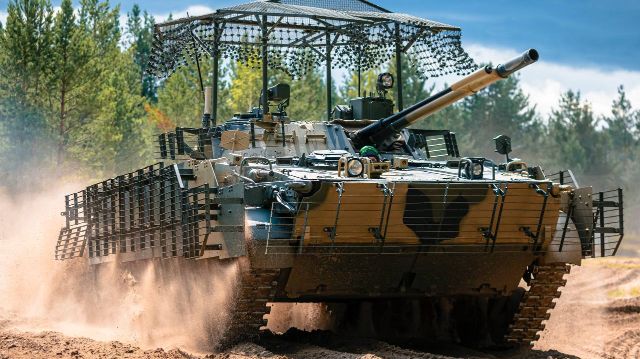On May 7, 2025, the Russian state corporation Rostec, through its High-Precision Systems Holding, delivered a new batch of BMP-3 infantry fighting vehicles to the Russian Armed Forces.

The vehicles, equipped with advanced protective systems and electronic warfare capabilities, were handed over ahead of Victory Day celebrations, marking a significant enhancement to Russia’s ground forces.
This delivery underscores Moscow’s ongoing efforts to modernize its military hardware, drawing on operational experience from the ongoing conflict in Ukraine. The upgraded BMP-3s are designed to balance mobility, firepower, and survivability, addressing the evolving demands of modern warfare.
The BMP-3, a mainstay of Russia’s mechanized infantry since its introduction in the late 1980s, is a versatile platform combining the roles of an infantry fighting vehicle and a light tank. The latest batch incorporates lessons learned from the special military operation in Ukraine, where the vehicle has been extensively deployed.
Each BMP-3 in this delivery is fitted with a comprehensive suite of additional protective measures. These include anti-cumulative grilles to deflect shaped-charge warheads, armored screens for enhanced resistance to small arms and shrapnel, and upper-hemisphere protection kits to counter threats from above, such as drone-dropped munitions.
Additionally, the vehicles are equipped with a specialized “cape” made of synthetic heat-insulating and radio-absorbing materials, designed to reduce their thermal and radar signatures. Electronic warfare systems have also been integrated to disrupt enemy communications and targeting systems, a critical feature in countering the increasing use of drones and precision-guided munitions on the battlefield.
Bekhan Ozdoev, a member of the Bureau of the Russian Union of Machine Builders and industrial director of Rostec’s weapons cluster, highlighted the BMP-3’s performance in combat. He noted that military personnel have praised its high mobility and off-road capability, which are essential for operations on challenging terrain.
The vehicle’s 100mm gun, paired with a 30mm autocannon, allows it to engage a wide range of targets, from fortified positions to armored vehicles. Ozdoev emphasized that the full suite of protective enhancements significantly boosts the BMP-3’s survivability without compromising its agility, making it a modern and highly effective platform.
His comments reflect Russia’s broader strategy of adapting its military technology to the realities of contemporary conflicts, where threats from drones, anti-tank weapons, and electronic warfare are increasingly prevalent.
The BMP-3’s design is rooted in Soviet-era engineering but has evolved significantly over the decades. The vehicle weighs approximately 18.7 tons and is powered by a 500-horsepower UTD-29 diesel engine, enabling a top speed of 70 km/h on roads and 45 km/h off-road.
Its amphibious capability, a hallmark of Russian infantry fighting vehicles, allows it to cross water obstacles without preparation, a feature that enhances its operational flexibility. The primary armament consists of a 2A70 100mm rifled gun, capable of firing both high-explosive shells and 9M117 Bastion laser-guided anti-tank missiles.
The coaxial 2A72 30mm autocannon provides additional firepower against lighter targets and infantry, while a 7.62mm PKT machine gun adds close-range defense. The BMP-3 can carry up to seven infantry soldiers, who dismount through rear doors, supported by firing ports for small arms.
Compared to Western infantry fighting vehicles, the BMP-3 occupies a unique niche. The American M2 Bradley, for instance, prioritizes troop protection and situational awareness, with a 25mm autocannon and TOW missile launchers for anti-tank engagements.
The Bradley’s armor is generally thicker, but it lacks the BMP-3’s amphibious capability and larger-caliber main gun. Germany’s Puma IFV, one of the most advanced in NATO, boasts superior electronics and modular armor but comes at a significantly higher cost and lacks the BMP-3’s ability to fire guided missiles directly from its main gun.
These comparisons highlight the BMP-3’s balance of firepower and mobility, though critics argue that its lighter armor makes it more vulnerable to modern anti-tank weapons, a concern the latest upgrades aim to address.
The delivery of these upgraded BMP-3s is part of a broader effort by Rostec to sustain and enhance Russia’s military capabilities amid the ongoing conflict in Ukraine. The High-Precision Systems Holding operates around-the-clock production schedules to meet the demands of the armed forces, with workers continuously refining designs based on battlefield feedback.
This iterative process has led to the integration of advanced technologies, such as electronic warfare systems and signature-reducing materials, which were not standard in earlier BMP-3 variants.
The focus on survivability reflects the evolving nature of the Ukraine conflict, where drones and loitering munitions have emerged as significant threats to armored vehicles. By equipping the BMP-3 with countermeasures, Rostec aims to extend the vehicle’s operational life and effectiveness.
Historically, the BMP series has played a central role in Soviet and Russian mechanized warfare. The BMP-1, introduced in the 1960s, was a pioneering design that combined troop transport with direct fire support, setting the template for modern infantry fighting vehicles.
The BMP-3, developed in the 1980s, built on this legacy by incorporating a more powerful armament and improved electronics. Its deployment in conflicts such as the Chechen Wars and Syria provided valuable data on its performance, revealing both strengths and vulnerabilities.
The current upgrades draw heavily on lessons from Ukraine, where the BMP-3 has been used in a variety of roles, from supporting infantry assaults to engaging enemy armor. The addition of upper-hemisphere protection, for example, responds directly to the proliferation of drones, which have been used extensively to target vehicles from above.
The timing of the delivery, just before Victory Day on May 9, carries symbolic weight in Russia, where the holiday commemorates the Soviet victory in World War II. The transfer of advanced military hardware reinforces the government’s narrative of strength and technological prowess, particularly in the context of ongoing geopolitical tensions.
However, the focus on the BMP-3 also highlights the challenges facing Russia’s defense industry. Western sanctions have limited access to advanced components, forcing manufacturers to rely on domestic alternatives or imports from non-Western partners.
While Rostec has managed to maintain production, questions remain about the scalability and long-term sustainability of these efforts, especially as the conflict in Ukraine continues to strain resources.
The BMP-3’s role in modern warfare extends beyond its technical specifications. Its ability to operate in diverse environments, from muddy fields to urban battlegrounds, makes it a critical asset for Russia’s ground forces.
The vehicle’s 100mm gun, capable of firing guided missiles, provides a level of firepower uncommon among infantry fighting vehicles, allowing it to engage tanks and fortified positions at ranges up to 5.5 kilometers.
The addition of electronic warfare systems further enhances its survivability by jamming enemy sensors and communications, a capability that has become increasingly important in countering NATO-supplied equipment in Ukraine. These upgrades reflect a broader trend in military technology, where adaptability and resilience are as critical as raw firepower.
Looking beyond the immediate delivery, the BMP-3’s evolution offers insights into Russia’s military priorities. The emphasis on electronic warfare and signature reduction suggests a recognition of the growing role of technology in shaping battlefield outcomes.
At the same time, the reliance on an existing platform, rather than an entirely new design, indicates a pragmatic approach to modernization, driven by cost and production constraints. This contrasts with Western militaries, which are investing heavily in next-generation platforms like the U.S. Army’s Optionally Manned Fighting Vehicle or France’s Griffon VBMR.
While these programs promise advanced capabilities, they also face delays and budget overruns, challenges that Russia’s incremental upgrades to the BMP-3 largely avoid.
The delivery of upgraded BMP-3s represents a tangible step in Russia’s efforts to maintain a capable and adaptable ground force. By incorporating advanced protective systems and electronic countermeasures, Rostec has addressed some of the platform’s vulnerabilities, ensuring its relevance in a rapidly changing threat environment.
Yet, the broader implications of this modernization effort remain uncertain. Can Russia sustain its production momentum in the face of economic pressures and international isolation? And how will the BMP-3 fare against increasingly sophisticated Western-supplied weapons in Ukraine? These questions linger as the conflict continues to shape the future of military technology and strategy.
In conclusion, the latest batch of BMP-3 infantry fighting vehicles delivered by Rostec’s High-Precision Systems Holding marks a significant milestone in Russia’s military modernization. The vehicles, equipped with enhanced protection and electronic warfare capabilities, reflect a deliberate response to the challenges of modern warfare, particularly in Ukraine.
While the BMP-3 remains a formidable platform, its success will depend on Russia’s ability to adapt to an evolving battlefield and overcome the constraints imposed by sanctions and resource limitations.
As military technology continues to advance, the BMP-3’s upgrades offer a case study in balancing innovation with practicality, raising broader questions about the future of armored warfare in an era of drones, precision munitions, and electronic dominance.

